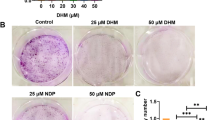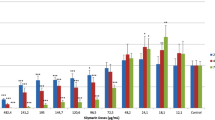Abstract
Objective
To evaluate the inhibitory effect of bear bile powder (BBP) on hepatocellular carcinoma (HCC) growth in vivo and investigate the underlying mechanisms.
Methods
A HCC xenograft mouse model was developed by producing with huh7 cells. After 5 days following xenograft implantation, ten HCC xenograft mice were given intra-gastric administration with 10 mg/(kg•d) dose of BBP or saline for 3 weeks. Tumor growth in HCC xenograft mice was evaluated by measuring the tumor weight and volume. Cell apoptosis, proliferation or tumor angiogenesis were examined via immunohistochemical (IHC) staining for transferase-mediated deoxyuridine triphosphate-biotin nick end labeling (TUNEL), proliferating cell nuclear antigen (PCNA) or cluster of differentiation 31 (CD31), respectively. Phosphorylation of signal transducer and activator of transcription 3 (STAT3) were determined by Western blot. The mRNA and protein expressions of Bcl-2, Bax, Cyclin D1 and Cyclin-dependent kinase 4 (CDK4) in HCC tumor tissues were respectively determined by reverse transcription polymerase chain reaction (RT-PCR) and Western blot. The protein expression of vascular endothelial growth factor A (VEGF-A) in tumor tissues was examined by IHC staining.
Results
BBP treatment led to a significant decrease on tumor volume and tumor weight in HCC mice (P<0.05) and had no effect on the change of body weight. In addition, BBP profoundly promoted cell apoptosis, inhibited cell proliferation and intratumoral microvessel density in HCC tumor tissues (P<0.05). Moreover, BBP treatment remarkably suppressed the STAT3 phosphorylation and modulated the expression of critical target genes including Bcl-2, Bax, Cyclin D1, CDK4 and VEGF-A in HCC mice.
Conclusion
BBP exerts its anti-cancer activities via suppressing STAT3 signaling pathway and affecting multiple intracellular targets.
Similar content being viewed by others
Explore related subjects
Discover the latest articles and news from researchers in related subjects, suggested using machine learning.References
Gordaliza M. Natural products as leads to anticancer drugs. Clin Transl Oncol 2007;9:767–776.
Ji HF, Li XJ, Zhang HY. Natural products and drug discovery. EMBO Rep 2009;10:194–200.
Gao XM. Ed. Chinese Materia Medica. Bejing: China Chinese Medicine Publisher; 2002:160–161.
Wang LY, Gao X, Tong ZL, Wang XG. Summary on pharmacological action and clinical study of the chemical composition of bear bile. Inform Tradit Chin Med (Chin) 2005;22:30–33.
Feng Y, Siu K, Wang N, Ng KM, Tsao SW, Nagamatsu T, et al. Bear bile: dilemma of traditional medicinal use and animal protection. J Ethnobiol Ethnomed 2009;5:2.
Sheng L, Zhang ML, Li H. Clinical observation on elimination of chronic hepatitis B induced jaundice in 33 CHB patients after administrated with xiongdan capsule. J Clin Hepatol 1994;7:40–41.
Jin Y, Wen YS, Cui YZ, Jin RH. Effects of bears’ bile on the expression of tumor cell p53 protein. Chin J Integr Tradit West Med (Chin) 2006;26:86–88.
Sun TM, Liang W, Zhang QM, Jin Y, Hu XH, Zheng XC. Anti–tumor effects of bear bile. Liaoning J Tradit Chin Med (Chin) 2003;30:66.
Zhao JY, Chen ZH, Lin W, Zhong XY, Chen XZ, Peng J, et al. Bear bile powder induces apoptosis of human hepatocellular carcinoma cells via mitochondrion–dependent pathway. Chin J Integr Med 2014;20:123–129.
Zhao JY, Lin W, Zhuang QC, Zhong XY, Peng J, Hong ZF. Bear bile powder inhibits angiogenesis in vivo and in vitro. Chin J Integr Med 2015;21:369–375.
Zhuang QC, Hong F, Shen AL, Zheng LP, Zeng JW, Lin W, et al. Pien Tze Huang inhibits tumor cell proliferation and promotes apoptosis via suppressing the STAT3 pathway in a colorectal cancer mouse model. Int J Oncol 2012;40:1569–1574.
Torre LA, Bray F, Siegel RL, Ferlay J, Lortet–Tieulent J, Jemal A. Global cancer statistics, 2012. CA Cancer J Clin 2015;65:87–108.
Herr I, Debatin KM. Cellular stress response and apoptosis in cancer therapy. Blood 2001;98:2603–2614.
Yang TS, Lin YC, Chen JS, Wang HM, Wang CH. Phase II study of gemcitabine in patients with advanced hepatocellular carcinoma. Cancer 2000;89:750–756.
Kanda T, Ogasawara S, Chiba T, Haga Y, Omata M, Yokosuka O. Current management of patients with hepatocellular carcinoma. World J Hepatol 2015;7:1913–1920.
Nguyen VT, Law MG, Dore GJ. Hepatitis B–related hepatocellular carcinoma: epidemiological characteristics and disease burden. J Viral Hepat 2009;16:453–463.
Lee WC, Lee CF, Cheng CH, Wu TJ, Chou HS, Wu TH, et al. Outcomes of liver resection for hepatocellular carcinoma in liver transplantation era. Eur J Surg Oncol 2015;41:1144–1152.
Bromberg J, Darnell JE Jr. The role of STATs in transcriptional control and their impact on cellular function. Oncogene 2000;19:2000,2468–2473.
Aggarwal BB, Kunnumakkara AB, Harikumar KB, Gupta SR, Tharakan ST, Koca C, et al. Signal transducer and activator of transcription–3, inflammation, and cancer: how intimate is the relationship? Ann NY Acad Sci 2009;1171:59–76.
Bromberg J, Wang Timothy C. Inflammation and cancer: IL–6 and STAT3 complete the link. Canc Cell 2009;15:79–80.
Zushi S, Shinomura Y, Kiyohara T, Miyazaki Y, Kondo S, Sugimachi M, et al. STAT3 mediates the survival signal in oncogenic ras–transfected intestinal epithelial cells. Int J Cancer 1998;78:326–330.
Masuda M, Suzui M, Yasumatu R, Nakashima T, Kuratomi Y, Azuma K, et al. Constitutive activation of signal transducers and activators of transcription 3 correlates with cyclin D1 overexpression and may provide a novel prognostic marker in head and neck squamous cell carcinoma. Cancer Res 2002;62:3351–3355.
Alvarez JV, Febbo PG, Ramaswamy S, Loda M, Richardson A, Frank DA. Identification of a genetic signature of activated signal transducer and activator of transcription 3 in human tumors. Cancer Res 2005;65:5054–5062.
Yang J, Cai X, Lu W, Hu C, Xu X, Yu Q, et al. Evodiamine inhibits STAT3 signaling by inducing phosphatase shatterproof 1 in hepatocellular carcinoma cells. Cancer Lett 2013;328:243–251.
Gu FM, Li QL, Gao Q, Jiang JH, Huang XY, Pan JF, et al. Sorafenib inhibits growth and metastasis of hepatocellular carcinoma by blocking STAT3. World J Gastroenterol 2011;17:3922–3932.
Rajendran P, Ong TH, Chen L, Li F, Shanmugam MK, Vali S, et al. Suppression of signal transducer and activator of transcription 3 activation by butein inhibits growth of human hepatocellular carcinoma in vivo. Clin Cancer Res 2011;17:1425–1439.
Calvisi DF, Ladu S, Gorden A, Farina M, Conner EA, Lee JS, et al. Ubiquitous activation of Ras and Jak/Stat pathways in human HCC. Gastroenterology 2006;130:1117–1128.
Author information
Authors and Affiliations
Contributions
Chu JF, Peng J, Shen AL and Liu LY designed the research; Shen AL, Liu LY and Chen HW performed the research; Chu JF, Shen AL, Liu LY and Chen HW analyzed the data; and Chen HW, Shen AL and Liu LY wrote the paper.
Corresponding author
Ethics declarations
The authors declare no financial or commercial conflict of interest.
Additional information
Supported by the Developmental Fund of CHEN Ke-ji Integrative Medicine (No. CKJ2013009)
Rights and permissions
About this article
Cite this article
Chen, Hw., Shen, Al., Liu, Ly. et al. Bear Bile Powder Inhibits Growth of Hepatocellular Carcinoma via Suppressing STAT3 Signaling Pathway in Mice. Chin. J. Integr. Med. 26, 370–374 (2020). https://doi.org/10.1007/s11655-019-3010-1
Accepted:
Published:
Issue Date:
DOI: https://doi.org/10.1007/s11655-019-3010-1




